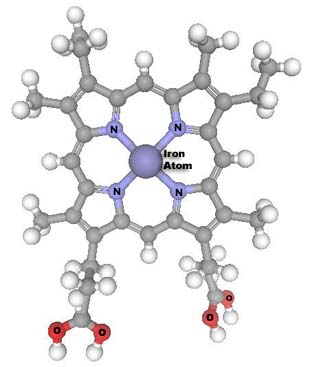|
One of the perennial stories that keeps appearing in "Believe-it-or-Not" columns and newspaper fillers is that all of the elements in the human body are worth only $1.25, $1.98, or $3.50, depending on the current state of the chemical market. This is an old cliché, which misses the essential point that makes diamonds more valuable than charcoal. In any collection of atoms, it is the arrangement of atoms that is as important, or more important, than the atoms themselves. The arrangement of iron and carbon atoms in the heme group in a protein, shown on the right, bears little resemblance to iron carbide, an inorganic compound that contains the same elements. Another frequently heard generalization is that a mammal is 65% water, and that this water is a dilute salt solution resembling sea water. In this view, a mammal is a walking bit of oceanic environment. This attitude is less of a cliché because it has a grain of truth in it. As we shall see in Chapter 26, the truth in this theory comes from the way in which life originally evolved in the oceans. Again, however, to say that a living creature is "only enclosed sea water" is to overlook the crucial importance of the nature of the enclosure. Right: Front view of the heme group, shown in side view on the following page. A similar heme group is found in the oxygen-carrying protein hemoglobin. Copyright © 1969 Dickerson and Geis; from R. E. Dickerson and I. Geis, The Structure and Action of Proteins, W. A. Benjamin, Inc. |

|